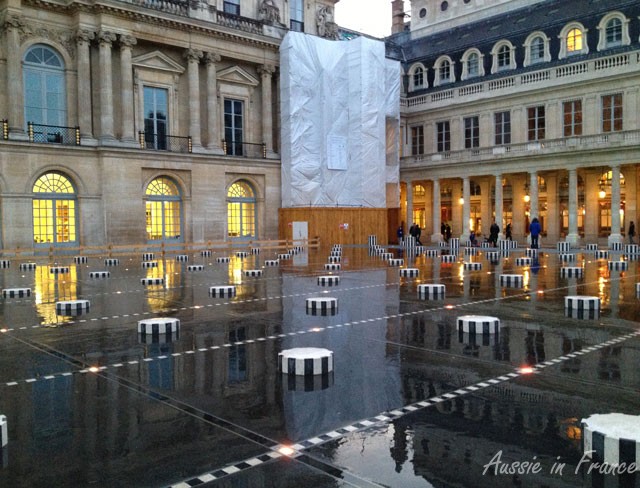 I know we could do without the scaffolding in the middle but the Buren columns between the Cour Constitutionnelle and the Palais Royal gardens remain photogenic no matter the weather!
I know we could do without the scaffolding in the middle but the Buren columns between the Cour Constitutionnelle and the Palais Royal gardens remain photogenic no matter the weather!
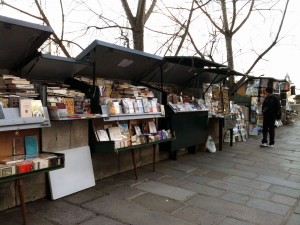 Last time, in Part 2, I told you about Saint Germain l’Auxerrois but the time before, in Part 1, I explained about Pont Neuf actually being the oldest bridge in Paris. After leaving Saint Germain, you turn left along the Seine to the bridge. Halfway across, there is an equestrian statue in honour of Henry IV and wonderful views on either side. Turn right after the bridge and you’ll go past the bouquinistes selling their second-hand books and anything else they think tourists might be interested in.
Last time, in Part 2, I told you about Saint Germain l’Auxerrois but the time before, in Part 1, I explained about Pont Neuf actually being the oldest bridge in Paris. After leaving Saint Germain, you turn left along the Seine to the bridge. Halfway across, there is an equestrian statue in honour of Henry IV and wonderful views on either side. Turn right after the bridge and you’ll go past the bouquinistes selling their second-hand books and anything else they think tourists might be interested in.
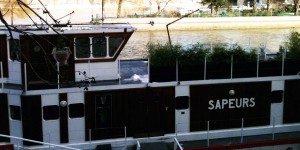 A little further on, you’ll see what is probably the most unusual fire station in Paris – it’s a river boat! Paris actually has a surprising number of fire stations. There are two in our neighbourhood alone. As soon as the weather permits, they take their fire trucks out in the street to clean them. I personally think they want to show off their uniforms as well! Last Sunday, when we were going to the market, there was a fireman standing by watching a firewoman (?) hosing down a truck – and giving instructions on how to do it, of course!
A little further on, you’ll see what is probably the most unusual fire station in Paris – it’s a river boat! Paris actually has a surprising number of fire stations. There are two in our neighbourhood alone. As soon as the weather permits, they take their fire trucks out in the street to clean them. I personally think they want to show off their uniforms as well! Last Sunday, when we were going to the market, there was a fireman standing by watching a firewoman (?) hosing down a truck – and giving instructions on how to do it, of course!
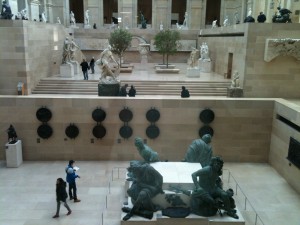 And now I have a bit of etymology for you. You might notice that the boat says “sapeurs“. Firemen in French are called “sapeurs-pompiers“. This is because in the Middle Ages, the first firemen often had to knock down (saper) the houses around the one that was burning to stop the fire from going any further. The “pompier” bit comes from pumping water.
And now I have a bit of etymology for you. You might notice that the boat says “sapeurs“. Firemen in French are called “sapeurs-pompiers“. This is because in the Middle Ages, the first firemen often had to knock down (saper) the houses around the one that was burning to stop the fire from going any further. The “pompier” bit comes from pumping water.
If you keep going, you’ll arrive at the Passerelle des Arts and can admire all the padlocks as you go past. Cross rue de Rivoli and walk through to the Place Carrée du Louvre, then left to the pyramids and right through the arcade with its wonderful plate glass windows and view of some of the museum’s antique sculptures.
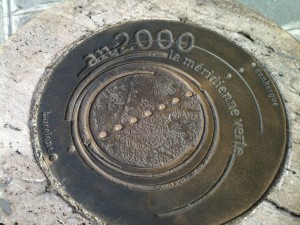 Just in front of the Conseil Constitutionnel, you’ll see a rather nondescript column with a plaque on top saying “an 2000 la méridienne verte“. This was a project promoted by Paul Chemetov to celebrate the year 2000. Trees were planted along the Paris meridian which crosses France from North to South (from Dunkirk to Prats-de-Mollo-la-Preste). A big picnic was held that year on Bastille Day right along the meridian. Wish I’d known about it!
Just in front of the Conseil Constitutionnel, you’ll see a rather nondescript column with a plaque on top saying “an 2000 la méridienne verte“. This was a project promoted by Paul Chemetov to celebrate the year 2000. Trees were planted along the Paris meridian which crosses France from North to South (from Dunkirk to Prats-de-Mollo-la-Preste). A big picnic was held that year on Bastille Day right along the meridian. Wish I’d known about it!
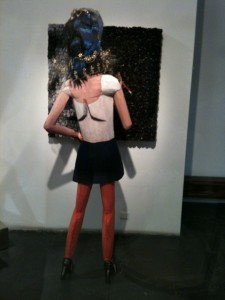 Turn right onto Place Colette, home of the Comedie Française theatre where Molière died, with its scaffolding, then through the arcade to the Buren columns. In front you’ll see a wooden building which is temporarily housing the theatre. Walk around it to the right and take a look at the exhibitions after the portico. They do have the weirdest things! But they’re often very clever, like the ones in the Pompidou Centre. A little look to see what Miss Bibi‘s up to and then I’m ready to climb the stairs to the 4th floor!
Turn right onto Place Colette, home of the Comedie Française theatre where Molière died, with its scaffolding, then through the arcade to the Buren columns. In front you’ll see a wooden building which is temporarily housing the theatre. Walk around it to the right and take a look at the exhibitions after the portico. They do have the weirdest things! But they’re often very clever, like the ones in the Pompidou Centre. A little look to see what Miss Bibi‘s up to and then I’m ready to climb the stairs to the 4th floor!
If you enjoyed reading this, don’t forget to subscribe to new posts – that way you’ll get them directly on your smart phone or in your mail box! And I love to hear your comments!
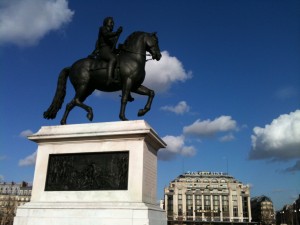 Not that the Pont Neuf’s really new – in fact it’s the oldest remaining bridge in Paris – but it was new at the time so that was what it was spontaneously called. If you’ve ever been to Venice and seen the Ponte Vecchio, you’ll have an idea of what most bridges used to look like in mediaeval days. The Pont Neuf, completed in 1607 during the reign of Henri IV (which is why there’s a statue of him halfway across) was the first bridge not to be covered. It was recently renovated and is now nice and new again.
Not that the Pont Neuf’s really new – in fact it’s the oldest remaining bridge in Paris – but it was new at the time so that was what it was spontaneously called. If you’ve ever been to Venice and seen the Ponte Vecchio, you’ll have an idea of what most bridges used to look like in mediaeval days. The Pont Neuf, completed in 1607 during the reign of Henri IV (which is why there’s a statue of him halfway across) was the first bridge not to be covered. It was recently renovated and is now nice and new again.
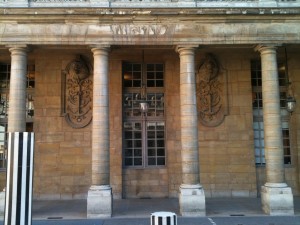 Anyway, I decided to go in the opposite direction today, starting with the Galérie des Proues (as in prow ergo all the anchors) which is the only remaining part of Richelieu’s palace which is how the Palais Royal all started. Then past the Buren columns and Arago’s meridian plaque, across Rue de Rivoli and through the first part of the Louvre until I reached the glass pyramids which are stunning on a sunny day. Down to the left and into the Place Carrée with another fountain. Right towards the river, opposite the Pont des Arts where they have the padlocks and left down towards the Hôtel de Ville.
Anyway, I decided to go in the opposite direction today, starting with the Galérie des Proues (as in prow ergo all the anchors) which is the only remaining part of Richelieu’s palace which is how the Palais Royal all started. Then past the Buren columns and Arago’s meridian plaque, across Rue de Rivoli and through the first part of the Louvre until I reached the glass pyramids which are stunning on a sunny day. Down to the left and into the Place Carrée with another fountain. Right towards the river, opposite the Pont des Arts where they have the padlocks and left down towards the Hôtel de Ville.
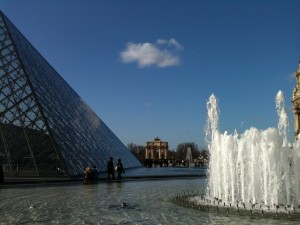 I think everyone’s heard the jokes about tourists mistaking the town hall (Hôtel de Ville) for a place to stay, but Actor Brother, who’s a country boy at heart, went one better. It was his first time in France and he’d rented a car and headed south (with his 12-year old son sitting in the back chanting his mantra “Dad, right is right, left is wrong”). It was getting late and he couldn’t find a hotel. Being Australian, he was expecting to see a motel appear at any time. Finally, he saw a big sign, “Hôtel de Police”. He headed off the highway, followed the directions and found himself in front of an unlikely looking building but, you know, it was France, and you could expect anything.
I think everyone’s heard the jokes about tourists mistaking the town hall (Hôtel de Ville) for a place to stay, but Actor Brother, who’s a country boy at heart, went one better. It was his first time in France and he’d rented a car and headed south (with his 12-year old son sitting in the back chanting his mantra “Dad, right is right, left is wrong”). It was getting late and he couldn’t find a hotel. Being Australian, he was expecting to see a motel appear at any time. Finally, he saw a big sign, “Hôtel de Police”. He headed off the highway, followed the directions and found himself in front of an unlikely looking building but, you know, it was France, and you could expect anything.
As he walked in, with his son close behind him, he realised something was wrong. “Euh, un hôtel?” he said in his basic French. The gendarme looked at him rather blankly but fortunately, a very helpful lady realised what was wrong and directed him to a more suitable place to spend the night than in the police lock-up!
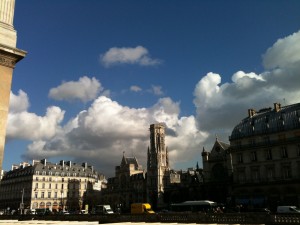 But the one I was walking towards is not the “mega hôtel de ville” as Leonardo so aptly used to call the palatial building opposite Notre Dame that is home to the Mayor of Paris, but the town hall for the 1st arrondissement. It’s still not bad as far as neo-renaissance buildings go. Black Cat has got her heart set on getting married there, but she’ll have to get a move on because once Relationnel retires and we move to Blois, it’ll be too late.
But the one I was walking towards is not the “mega hôtel de ville” as Leonardo so aptly used to call the palatial building opposite Notre Dame that is home to the Mayor of Paris, but the town hall for the 1st arrondissement. It’s still not bad as far as neo-renaissance buildings go. Black Cat has got her heart set on getting married there, but she’ll have to get a move on because once Relationnel retires and we move to Blois, it’ll be too late.
In France, there’s none of that getting-married-in-a-garden-or-on-the-beach business that goes on in Australia. Here, you can only get married in the town hall of the place of residence of one of the spouses (or their parents if you can claim you’re still living at home). And having a church wedding doesn’t do away with the civil ceremony either which can complicate the logistics a bit.
I was going to tell you about the church of Saint Germain l’Auxerrois next door, a favourite with Valois royal family in Renaissance times, but I got a bit distracted and I wouldn’t like leave out any of the interesting bits so it’ll have to wait for next time.
Don’t forget to subscribe to new posts – that way you’ll get them directly on your smart phone or in your mail box! And I love to hear your comments!
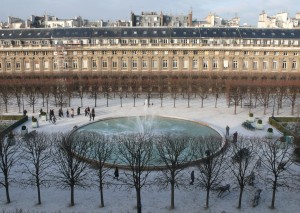
Imagine my surprise when I looked out the window on 2nd January 2008 to see a pack of wolves in the Palais Royal gardens, made even more realistic by a blanket of snow! Even up close they were pretty convincing. The sculpteur, Olivier Estoppey, had managed to make them look as though they were running. They disappeared after a while and, to my great surprise, turned up again in a French detective film called Le Crime est notre affaire.
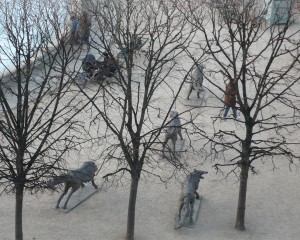 It’s because we’re next to the French Ministry of Culture that the Palais Royal gardens are often the site of temporary exhibitions sponsored by an association called Sculptures au Palais Royal. Some, like the wolves, are truly artistic, but most of them are modern sculptures that I personally think are awful. Maybe it’s a question of generation because Thoughtful, who’s 22, thinks they’re wonderful. He likes the contrast between the old and new. Being Australian, I just like the old!
It’s because we’re next to the French Ministry of Culture that the Palais Royal gardens are often the site of temporary exhibitions sponsored by an association called Sculptures au Palais Royal. Some, like the wolves, are truly artistic, but most of them are modern sculptures that I personally think are awful. Maybe it’s a question of generation because Thoughtful, who’s 22, thinks they’re wonderful. He likes the contrast between the old and new. Being Australian, I just like the old!
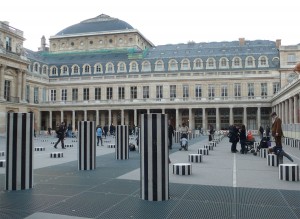 Of course, the Palais Royal’s most famous “sculpture” is Les Deux Plateaux, better known as the Buren columns. These “stripey” black and white columns of different sizes are very popular with tourists but they are also a wonderful playground for the local kids who come up with all sorts of inventive games. They climb on them, slalom around them on their little scooters and bikes and put their dolls on top.
Of course, the Palais Royal’s most famous “sculpture” is Les Deux Plateaux, better known as the Buren columns. These “stripey” black and white columns of different sizes are very popular with tourists but they are also a wonderful playground for the local kids who come up with all sorts of inventive games. They climb on them, slalom around them on their little scooters and bikes and put their dolls on top.
When work first began on the columns in 1985 on the site of a parking lot, it caused a furore. The objectors eventually managed to find a legal loophole and have the work stopped. By then it had escalated from a discussion on the appropriateness of modern art in an historical context to a major political debate.
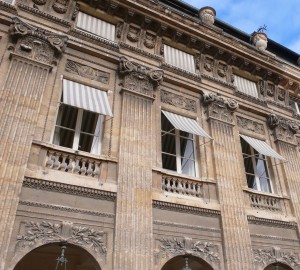 Every day after work, Relationnel used to stop by and read the day’s graffiti, slogans and caricatures on the boardings around the worksite. Everyone seemed to have joined the debate. It became increasingly heated and venemous with insults and slander on every side. The French daily Le Figaro launched a major offensive which ultimately won the day and the work was finally resumed in 1986. Major renovations were carried out and completed in 2011 so the columns are all looking very spruce.
Every day after work, Relationnel used to stop by and read the day’s graffiti, slogans and caricatures on the boardings around the worksite. Everyone seemed to have joined the debate. It became increasingly heated and venemous with insults and slander on every side. The French daily Le Figaro launched a major offensive which ultimately won the day and the work was finally resumed in 1986. Major renovations were carried out and completed in 2011 so the columns are all looking very spruce.
When I first saw them, I didn’t like them at all because I couldn’t see any connection between the so-called “sculpture” and the Palais Royal but when I realised that the stripes were actually a reflection of the regulatory grey and white striped blinds on my windows, I adopted them!